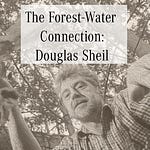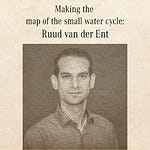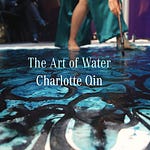Peter Andrews, also known as PA, was an Australian racehorse breeder who in the 1970s bought a piece of property, in the state of New South Wales, to raise racehorses. However the land he bought, the Tarwyn Park property, was degraded and the water on it was salinated. After a lot of thought and experimentation he developed his own set of restoration techniques.
He looked at the dried up patterns in the floodplains to figure what used to happen on the land. He saw there used to chains of ponds. So he started to work to rehydrate the floodplains. He repaired the degraded flow lines. He used willows and reeds to restore the river banks.
But the neighbors keep bringing the authorities to try and stop what he was he was doing. Stubborn, brash, and confident, and because he knew he was onto something important, he continued to work anyways.
The plants started bringing back the wet paddocks, and refilling the aquifers. The land turned into a flourishing, vibrant landscape.
The work became known as Natural Sequence Farming. Peter Andrews went around around proselytizing the work - badgering governments, media and land owners, to get them interested. This was a process, he said, which could save Australian farming, help them stay hydrated even with the droughts. His work got on the Australian news, and word spread.
The focus on getting the message out though meant Peter lost sight of running the farm as well, and the bank foreclosed on his property. But then Stuart Andrews, his son, was able to buy back the Tarwyn Park property back from the bank. Stuart had to teach himself the ways of Natural Sequence Farming to run the farm. He then worked with Duane Norris to build a training program there to teach others the same techniques. ( I had became friends with Duane a little while back, and he was very encouraging of my work during the early stages of writing this newsletter. I recruited Duane in my project three years to develop a set of principles that succinctly encapsulated the important aspects of the hydrological cycle.)
Tony Coote, a successful jeweler, who had bought a property on 3 kilometers of Mulloon Creek in the 1960s. He approached Peter Andrews about restoring it. Early on the brought 6 truckloads of blackberries trees and canes to plant, which then started a feedback loop that slowed the water down, which then brought in more vegetation. Fish started coming back. And now there is a Mulloon Institute that teaches and consults on the Natural Sequence Farming work also.
……………………………..
Here is info about Natural Sequence Farming from the Tarwyn Park Training site :
Natural Sequence Farming (NSF) is
“a regenerative practice that restores landscape function, soil health, water retention, and biodiversity by working with natural processes. It explores the principles, emphasises the role of plants and water, and provides practical insights for implementing these principles in your own landscapes.
The key to NSF is that plants manage water; that's what built all the environments we see. Plants are the engineers that build everything, and water is the carrier of the nutrients that feed them. Our landscapes operate in a continuous feedback loop connecting three main areas: Accumulation - The highest area where fertility is built. Production - The area where production takes place. Filtration - The lowest area where fertility is recycled.
Our landscape no longer operates like this; it has become disconnected due to the way humans have managed their land. Natural Sequence Farming is the solution to that. It is about understanding how this system works and implementing works to reconnect the pieces like a puzzle. We need to understand the landscape first. And once we recognise the landscape and how it functions, it is about setting it up to work correctly once again.”
[aerial view of Tarwyn park, photo from Tarwyn Park Training]
The five principles of Natural Sequence Farming (NSF) are:
1) Slow the Flow: Emphasizing the importance of slowing down water flow to allow infiltration into the soil.
2) Let All Plants Grow: Promoting plant diversity and allowing natural regeneration of the landscape.
3) Careful Where the Animals Go: Integrating livestock management with the natural sequence of the landscape.
4) Filtration is a Must Know: Understanding the role of natural filtration systems in purifying water.
5) Return to the Top to Recycle the Lot: Recycling nutrients and resources by returning waste products to the top of the soil.
…..
I was really honored to get a chance to interview Stuart Andrews, the son of Peter Andrews. Below is part of our interview (slightly edited):
Stuart: PA [Peter Andrews] was running a horse stud farm at the time. He wanted to expand. He wanted to be able to produce the best racehorses. So he was looking for an area where he could potentially produce the best racehorse. So he looked around and he realized that the horse market was better in New South Wales.
So he then looked for a property over there. The horse salespeople told him about this property that had come up that was in the 1940s-1950s, one of the leading stud farms in New South Wales, producing some of the best horses. But it had deteriorated. It had salinity come in, so now it wasn't performing the same. Animals generally had ill health.
So he was able to get it at a fair price. So he purchased that, and that's where his real experimentation started off, because he had a place now that was full of what would be determined as weeds, and that had this high water table—but saline water. So it was restricting the growth.
So he had a fairly degraded landscape to work from. So he thought how do I get that functioning again? He started reading these patterns in the landscape. And once you've been out there, and you spend enough time looking at the landscape, you can realize that the patterns are the same everywhere you go. They just vary in size.
You're looking for the patterns that water has created over the landscape. And in conjunction with plants, what role did the plants play to enable that transition to happen?
So Tarwyn Park was predominantly, mostly what we would call floodplains. So it was probably more than half—maybe 60 or 70%—of the property was floodplain. So therefore, it had the potential to have an aquifer of fresh water underneath it. And that's how it evolved. It evolved to be like that.
But since white man had come in, the landscape had deteriorated. They cut a channel right through the floodplain. So instead of the floodplain filling with fresh water, it was recharging from the side elevation with saline water out of the ridges, out of the slopes. And the fresh water all ran away out through the eroded channel.
And I see the same thing in the States. It's no different. You’ve got all of these now-eroded channels which drain the landscape. Our whole landscapes around the world are set up as drainage mechanisms. So Australia, because it's such an arid environment, generally—when white man came here—they set about draining the only areas that were quite wet. And the drainage ended up being uncontrollable because the vast amount of water moving down these systems created bigger eroded channels.
So he said, well, this landscape can’t function as a drainage landscape. What do we need to do to turn it around from a drainage landscape into a landscape that recharges, recharges the aquifer.
He started playing around in the creeks—what we would refer to as a creek, which really is just a drainage line. It’s an eroded channel. But what our government determined this eroded channel to be—they just called it a creek, rather than recognizing that it never actually existed prior to agriculture taking place. Those creeks were never there. It was generally what was referred to as a chain of ponds—so water was ponding, slowing, then moving on and repeating this pattern as it went down the line.
Alpha: The chain of ponds that disappeared by the time he got there?
Stuart: Yes. Yeah. It was already an incised channel by that stage. The eroded channel cuts through the floodplain. Everything that goes into the floodplain leaks into the channel and then runs away.
It never used to be like that before, because the landscape had created what we call steps. They’re areas where the landscape levels out slightly, and the type of plants that grow there are able to manage the flow of water. So rather than allowing the water to freely flow away, it would grow this dense vegetation—what we call reeds would grow in this area—and the reeds would manage how quickly the water moved. So they would create these ponds behind vegetation rather than behind earthen banks.
The plants build everything. You know, all of our landscapes around the world were built by plants. It’s only when we came in—doesn’t matter what humans they were, whether they were Indigenous or white people coming into landscapes—we all have an impact on a landscape. If we’re running animals that are interfering with the plant species, then those animals have the potential to remove the plants that are critical to managing that system.
The whole idea is that because the plants are no longer there and the system is so degraded now, the plants can’t manage it. So the plants need help.
And so with Natural Sequence Farming - that was what it ended up being called- that’s where you can come in with soft engineering to manage that initial flow so the plants can take over. And it’s critical that if we don’t understand that these processes are all run by plants—if we focus on the engineering as the solution—we will just fail every time. Because the Australian landscape was built and managed by plants.
Now, something that I think is critical in what he’s tried to get across to people is that the Australian landscape is the laboratory for the world. Because it’s the oldest, the flattest, the driest inhabited continent in the world—with the least amount of climate backups.
It holds all the keys to how we can rebuild landscapes everywhere—no matter where they are. See, Australia didn’t have snow or ice forming in the high country to provide a controlled release of fertility and water over the landscape each year like we did. Australia hasn’t had that for millions of years since it separated from Gondwanaland.
So the big question is: why didn’t everything wash into the sea? Because by all accounts, it should have. In just the last 200 years, since European settlement, an enormous amount of soil has been lost into the ocean. If you extrapolate that over a few million years, the continent shouldn't even be here anymore. Why didn’t it all wash away? That’s the critical question. The processes that stopped that from happening—those are what we need to understand. If we can replicate those processes, we can reverse desertification anywhere in the world.
Where do you find these chains of ponds? Mainly on floodplains and flatter systems, but you’ll also find them on slopes, typically along flow lines—because water always concentrates where gravity pulls it.
And I think anyone living in a suburban street can observe this. After a rain event, look at the gutters. You’ll see spots where soil or leaves have accumulated and formed little ponds. One pond here, another down the line—each formed from deposited material. That’s how a landscape builds. That’s how it functions. And all you have to do is repeat that.
But first, we need to open our eyes and read what the landscape is telling us. These processes exist everywhere. Wherever water flows, it behaves the same. If it’s carrying material—rocks or fine sediment—it deposits them based on the water’s energy. Coarse material drops out first, finer stuff settles later.
If you watch a gutter during a rain event, you’ll see larger particles dropped early, finer particles farther down. Leaves tend to float to the edges, to higher ground, while coarse materials settle in the flow line. That’s the beginning of a process. Next, plants start to grow in the finest material, where the soil is most fertile. If the street sweepers don’t come through and remove it, the plants start to manage the system. Every time it rains, the plants trap more silt, building more soil. Water flows around them, spreads out, slows down, then gathers again. You’ll see this zig-zag pattern—out around the plants, back in, out again. Have you seen that? Been out in the rain and watched how it works? It’s like a feedback loop—leaves, silt, and water weaving together. These patterns are usually overlooked. Our brains struggle to grasp processes that unfold over time. Plants take time to rebuild a landscape. Our role is just to start that process.
That’s it. We’re not going to rebuild everything all at once. We just need to put little pieces back in place, start the process, and then let it run. The faster we get plants growing, the faster the system restores itself.
So what’s the nudge to get it going? Rather than waiting for natural deposition, we read the landscape—ask it where this used to happen, before erosion took over. Where did water used to slow down?
You go to those points and use earth—because earth grows the best plants. In high-velocity scenarios, like rivers, maybe you use rocks or timber—something stable. Once you get deposition going again, the plants will come. Then the plants manage the system forever.
All we have to do is stop removing the plants. That’s it. The whole landscape will rebuild itself. So yeah, that’s what Dad was trying to do, trial and error to figure out what worked. How long before he got it right? We’re still working on it. Still trialing, because every scenario is different.
But the key is understanding: what’s the one limiting factor? What reduces the success of everything we try? It’s the energy moving the water. In our training, when we talk to farmers or land managers, we say this: two main forces run a farm—sunlight and gravity. That’s it. Those two energies build or destroy a system.
Now think—what does a landscape look like where those two energies aren’t being managed?
If gravity isn’t managed, everything washes away. If sunlight isn’t managed—if you’re not capturing it with plants—nothing grows. So what do you call that? A desert.
And that’s what we see, even in places we think are productive. Drive through cropping country—in the U.S., corn and soy; here, wheat and cereals. In summer, once the crop’s harvested, there’s nothing green left. Could be the best soil, but it’s still a desert. Because there’s no green plants managing sunlight or holding soil in place. It’s a dysfunctional landscape.
So we base everything around managing those two energies. The simplest way to do that? Grow more plants.
Peter Andrews came to Tarwyn Park, did his research, ran a development project to prove the validity of this landscape science—which has always been out there. It’s not new. It’s just that no one paid attention.
We keep thinking about how much we can impose on the landscape, rather than asking: how did nature do it for millions of years without our help? So he asked the landscape: how did you manage yourself? Because the continent hasn’t washed into the ocean. That alone proves it worked.
How do you figure out how the land used to function? By reading the landscape. It’s written out there, in the patterns.
Take the gutter example again. Water moves out, back in, out, in—it splits, spreads, then reunites. That divides and dissipates energy. Water de-energizes itself through movement. So how did the land do that? With plants.
If we can do it with plants, that’s the first goal. But in many places today, things are too degraded for plants to manage it on their own. So we use soft engineering to recreate those patterns of water movement. Even in degraded systems, you can see remnants of those patterns trying to reform—but the energy is too great.
Once you’re out in the field, it’s easy to see. Hard to describe here, but once you see it, you can’t unsee it. The same patterns repeat, just at different scales. What you see in a gutter happens on a floodplain.
If you looked at a map—here or in the States—of a floodplain system, you’d see the same pattern. Water leaves the main channel, flows out, then returns. Out and back in. It’s like an hourglass, not just a snake. Indigenous people in Australia saw these patterns. They painted them—used them in their art. Most of us think of rivers as winding snakes. But that’s just part of the system. There are other arterial flows that only activate during floods—patterns that help de-energize the river. But most rivers today are so deeply eroded that water rarely gets out of the banks, so those patterns never engage.
It’s like being a detective—reading the flows and energies of the past. And yes, it depends on the plants too. They’re part of it. When we recreate that, we slow water enough for it to infiltrate the soil and recharge aquifers. That means plants can access that moisture during dry seasons.












